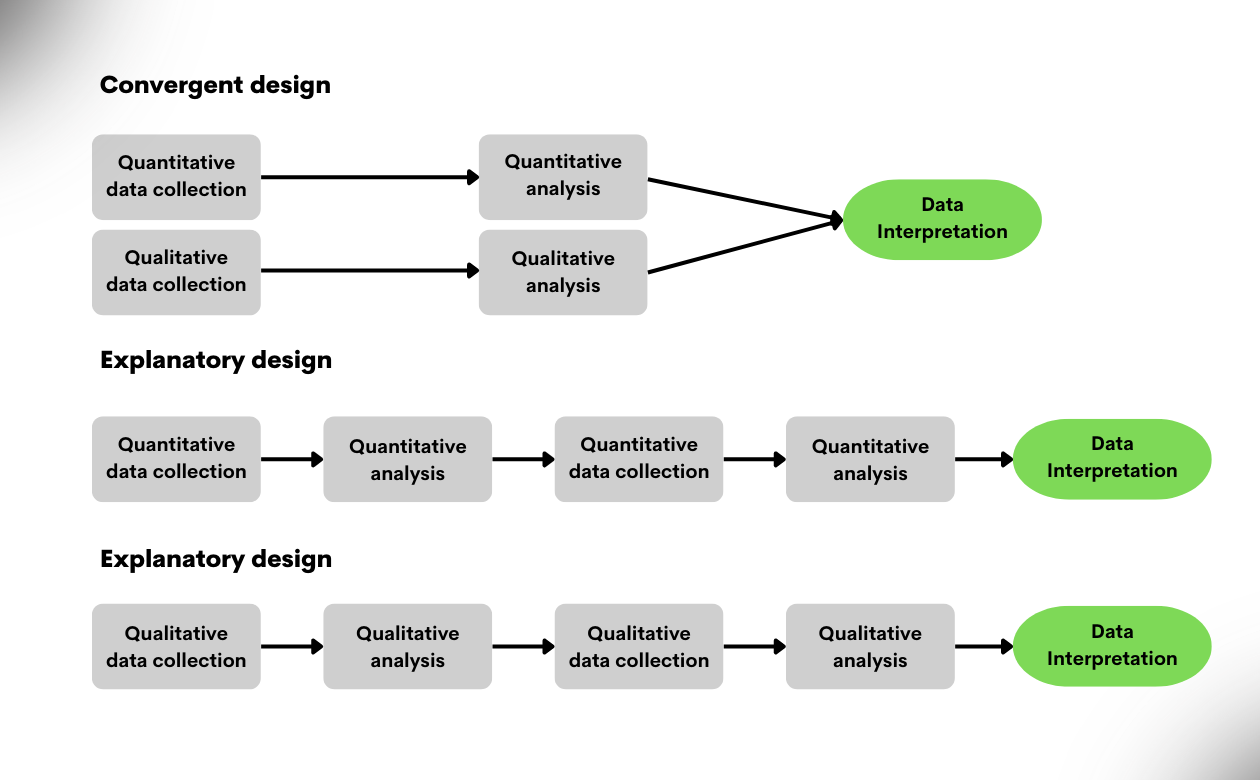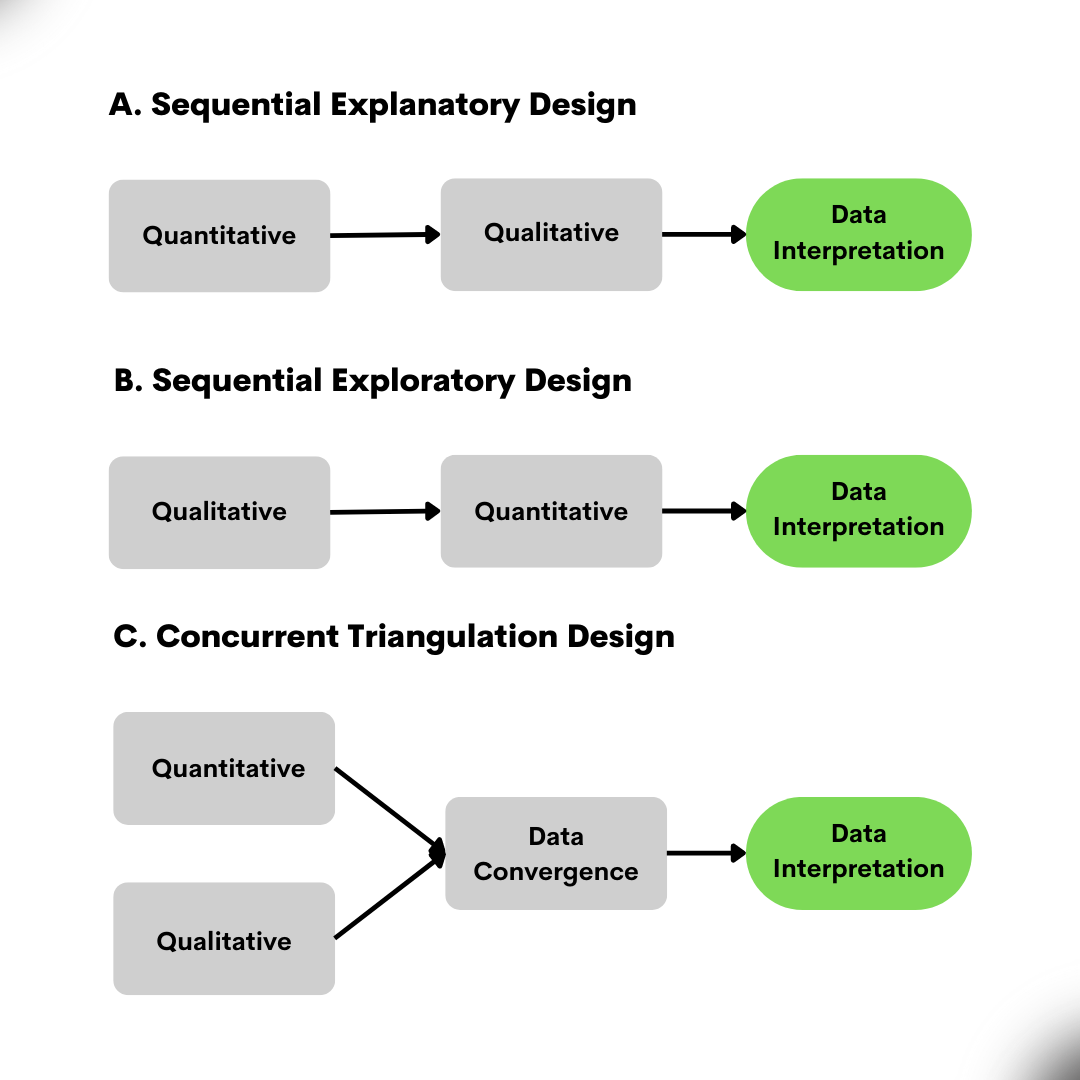As someone who would have identified at the beginning of their PhD as a qualitative researcher, a consequence of doing qual research in the past and not because of any partisan faith to the paradigm, embracing mixed methods research has been both challenging and rewarding.
Through the process of planning and conducting mixed methods research I have engaged with the challenges relating to definition, design, and more recently, the messiness of actually doing mixed methods research in an applied context.
In this post I summarise the things you’ll need to think about when planning a mixed methods research study, including characteristics and key design elements like sequencing, point of interface, and methodological priority.
Characteristics of mixed methods research
There are varying ways mixed methods research [1] has been defined since the paradigm emerged in the mid-to-late 1980s. For example, mixed-method (with hyphen), mixed methodology, methodological triangulation, multimethod research, integrated research, combined research, and mixed research. The nature and controversies of definitions depend on the ‘scientific community’ and focus of the work, whether that be methods, methodology, or methods, methodology and philosophy.
Given the evolutionary nature of concepts of mixed methods research, another approach to what Creswell and Clark describe as a “vague and often confusing priority”, that is a definition of mixed methods research, is to understand the key characteristics and appraise your research in respect of these. This should avoid the use of acontextual definitions borrowed from others.
There is general consensus that key characteristics of mixed methods research are the:
- Collection and analysis of both qualitative and quantitative data
- Integration of qualitative and quantitative data sets
- Organisation of research processes into a specific research design that provide the logic and procedure for conducting the study, and
- Framing these procedures within theory and philosophy
Key mixed methods research designs
Once you understand the key attributes it is much easier to apply them to a mixed methods research design. For example, if you need to firstly develop understanding of a phenomena to discover hypotheses to test, you may find yourself using an exploratory mixed methods design. Examples of the key mixed methods research design are provided below but if you wish to delve deeper into more complex designs such as mixed methods evaluation and trials Creswell and Clarks 2017 guidance listed at the bottom of this post is where I would go.

Creswell, J. W., & Clark, V. L. P. (2017). Designing & conducting mixed methods research + the mixed methods reader. Designing & Conducting Mixed Methods Research + the Mixed Methods Reader, 1(2), 24–27.
A further consideration at this point is the sequencing of qualitative and quantitative phases in the research design. For example, applying the earlier example, exploring an area to uncover a hypothesis to test would suggest a sequential design whereby the initial qualitative phase informs the quantitative phase. This would be called an exploratory sequential mixed methods research design. Examples of sequencing in mixed methods research are provided below.

Greene, J. C. (2007). Mixed methods in social inquiry. John Wiley & Sons.
Point of interface between quantitative and qualitative data sets
Understanding and clarifying the point at which qualitative and quantitative phases interface, [2] integrate, or connect as it has been termed, is an integral part of mixed methods research. Key types of integration are presented below.

Tashakkori, A., & Teddlie, C. (1998). Mixed methodology: Combining qualitative and quantitative approaches (Vol. 46). Sage
Considering and clarifying the point of interface ensures you are not just reporting on ‘distinct strands of qualitative and quantitative research’ and instead engaging with questions relating to the approach and purpose of mixing methods, for example through comparison, connection, or assimilation of different data sets. A thread on ResearchGate [3] suggests asking yourself the following questions to determine the point at which quantitative and qualitative phased mix.
- Is my quantitative aspect descriptive and cross-sectional or analytical and cohort longitudinal while my qualitative aspect historical or narrative?
- Are data collection and analysis in my study to be done at same time (concurrent) or in succession (sequential)?
- Is the mix coming up during data collection, analysis and/or interpretation? Am I going for merge, build, connect or embed?
- Should the analysis, interpretation and discussion of quantitative and qualitative data be triangulated?
Weighting quantitative and qualitative phases
As well as determining the sequencing or order of quantitative and qualitative phases in the design, their priority needs to be clarified also. Simply this means considering out of each which has greater importance in the study. Once you are aware of the order and priority of the mixed methods design you can apply a formula. For example, in my research I use a sequential mixed methods design whereby qualitative research methods inform the development of quantitative procedures. Each phase is given equal priority also referred to as dietetic pluralism. A simple formula for this mixed methods research design is QUAL + QUAN, other formulas you may come across are presented below.
- QAUNT + qual = quantitative first with higher priority and qualitative second with lower priority
- quant+ QUAL = quantitative first with lower priority and qualitative second with higher priority
- quant + qual = quantitative first and qualitative second and both have equal priority
- qual + quant = qualitative first and quantitative second and both have equal priority
Dealing with the complexities of key mixed methods research design elements such as those that have been merely touched on in this post, is key to helping you convey methodological rigour and for those less familiar with mixed methods paradigm, providing guidance and aiding accessibility.
Nathan

Nathan Stephens
Author
Nathan Stephens [4] is a PhD Student and unpaid carer, working on his PhD at University of Worcester, studying the Worcestershire Meeting Centres Community Support Programme. Inspired by caring for both grandparents and personal experience of dementia, Nathan has gone from a BSc in Sports & Physical Education, an MSc in Public Health, and now working on his PhD.